North Korea’s Pursuit of an ELWR: Potential Power in Nuclear Ambitions?
Recent indications from the International Atomic Energy Association (IAEA) and several analysts, including experts at the Center for Nonproliferation Studies, propose that North Korea’s Yongbyon Nuclear Scientific Research Center’s Experimental Light Water Reactor (ELWR) likely began operations in October of 2023. While North Korea initially built the ELWR for energy production, concerns arise that it can be repurposed for plutonium production. Here, we examine the ELWR’s operational status using newly acquired high-resolution thermal and electro-optical images. A heat signature at the power switchyard supporting the ELWR, combined with a continuous surge of warm water discharge at the suspected cooling lines, suggests that the ELWR may be undergoing pre-operational testing or is in the early stages of operation. Notably, the muted heat signature of the ELWR reactor dome compared with the 5 MWe Reactor indicates that if the ELWR is operational, it is likely operating at a reduced power level than as initially designed.
When operating at full capacity, the ELWR could significantly increase North Korea’s fissile material stockpile, facilitating Kim Jong Un’s stated ambition for an “exponential increase of nuclear arsenals.” Therefore, while North Korea has not yet provided any concrete data regarding the progress of the ELWR, it remains imperative to monitor its status.
Background
When the 1994 US-North Korea Agreed Framework—aimed to freeze North Korea’s indigenous nuclear power plant development in exchange for the two light water reactors—led to no promising outcome, North Korea decided to build its own light water reactor, which led to the Experimental Light Water Reactor (ELWR). The reactor marked North Korea’s second domestically-built reactor, following the 5-megawatt energy (MWe) (or 25 MW-thermal, MWth) graphite-moderated CO2-cooled reactor (GCR) designed for plutonium production—a critical component for nuclear weapons. Unlike the 5 MWe Reactor, the ELWR is intended for energy production, although it can be repurposed for plutonium production. In addition to these two reactors, North Korea has a Soviet-supplied IRT-2000 research reactor at Yongbyon as well as two never completed 50 MWe and 200 MWe gas-graphite reactors at Taechon, whose construction was successfully suspended by the Agreed Framework, and two unfinished light water reactors at Kumho that were the focus of Korean Peninsula Energy Development Organization (KEDO) efforts.
Designed as a 100 MWth pressurized light water reactor, the ELWR was to serve as a prototype for a larger electricity-producing light water reactor. When fully operational at maximum capacity, this reactor would provide enough electricity for ~100,000 North Korean households. Yet North Korea faced significant delays in achieving its goal, likely due to technical challenges in completing the cooling system and producing suitable fuel for the new reactor technology.
North Korea decided to build the ELWR in April 2009, and the reactor appeared externally complete by 2013 (Figure 3).[1] Subsequently, moderate activity was observed between 2013 and2020, such as the installation of pipelines purposed for the reactor cooling systems and subsequent water discharge, vehicle presence throughout the complex, and snowmelt. But for over a decade since its construction, definitive evidence substantiating the ELWR’s core engagement remained elusive.
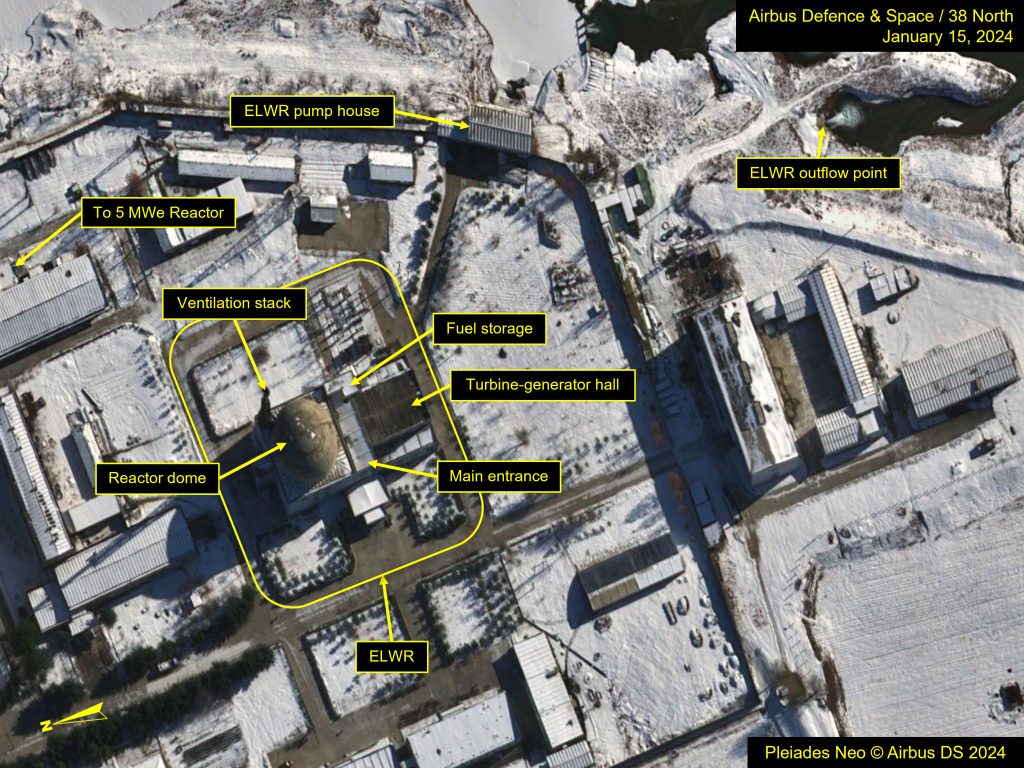
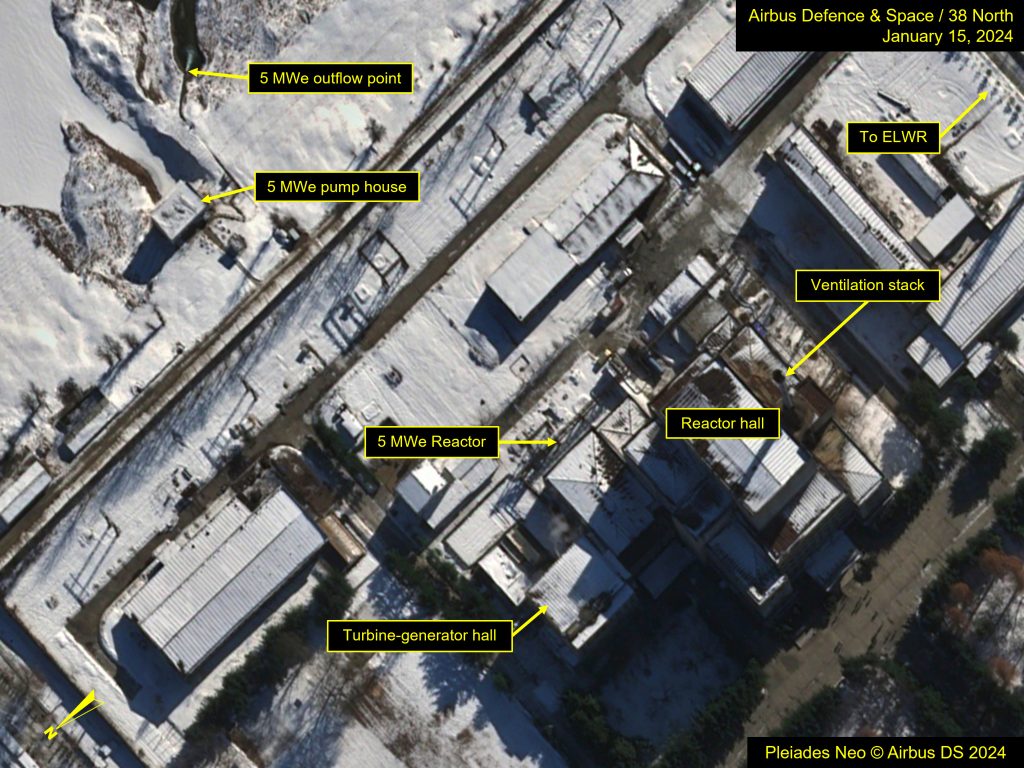
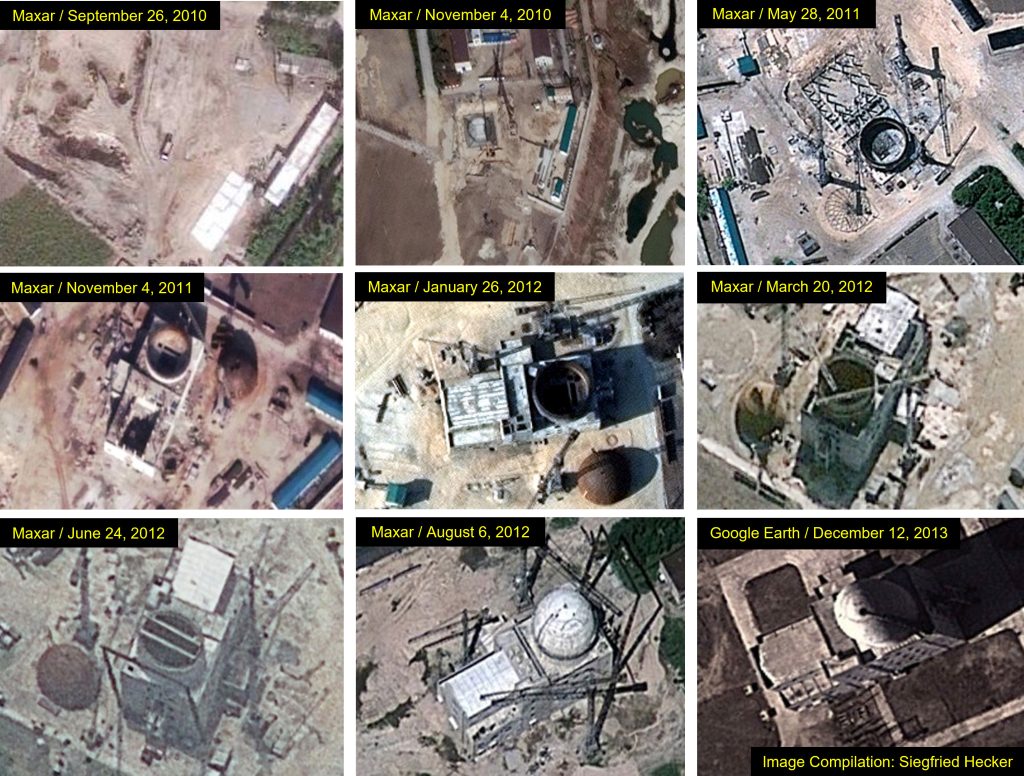
Optical Imagery
The recent developments at the Yongbyon Nuclear Research Center indicate North Korea’s dedication to bringing the ELWR online, along with the continued operation of the 5 MWe Reactor.
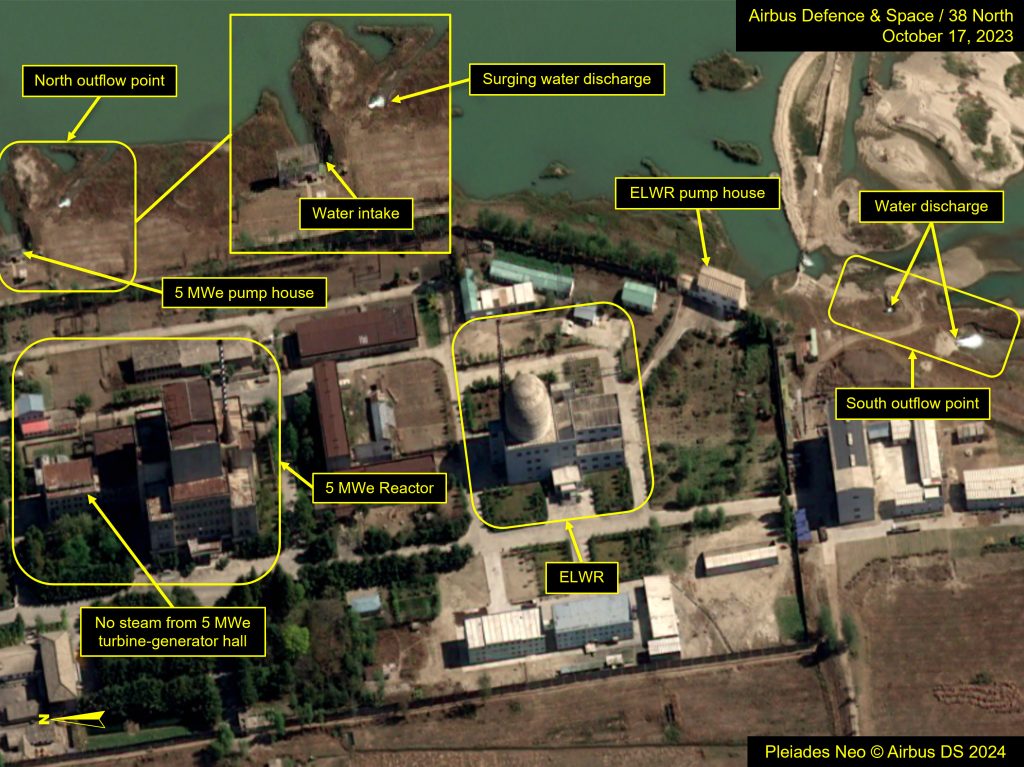
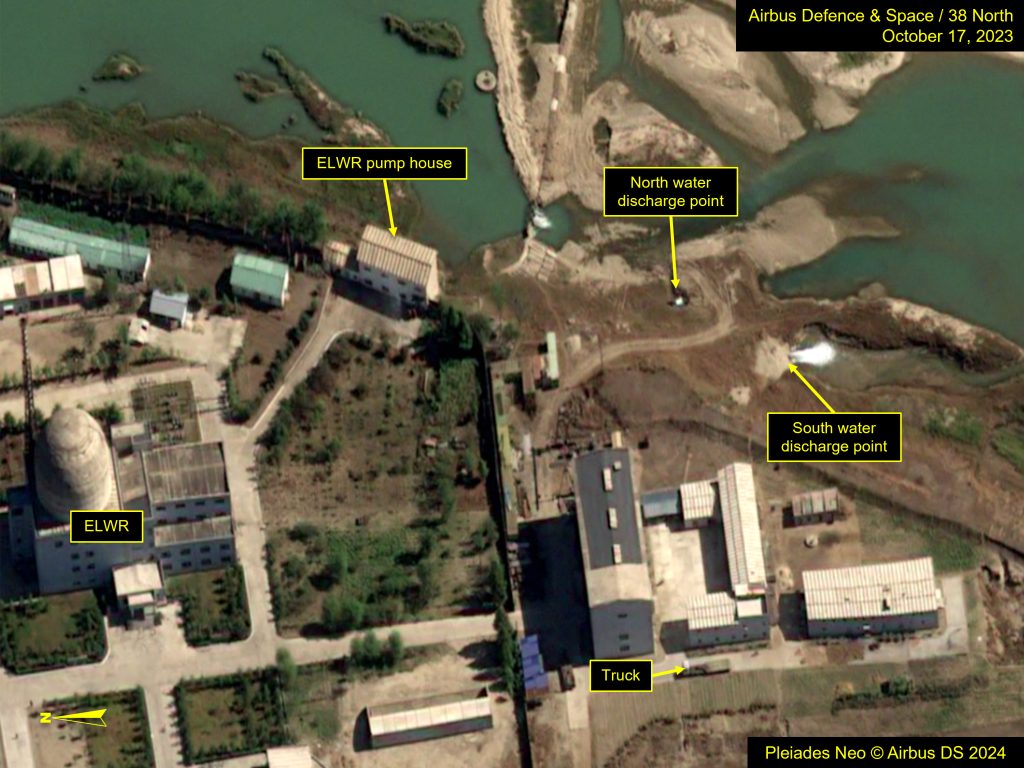
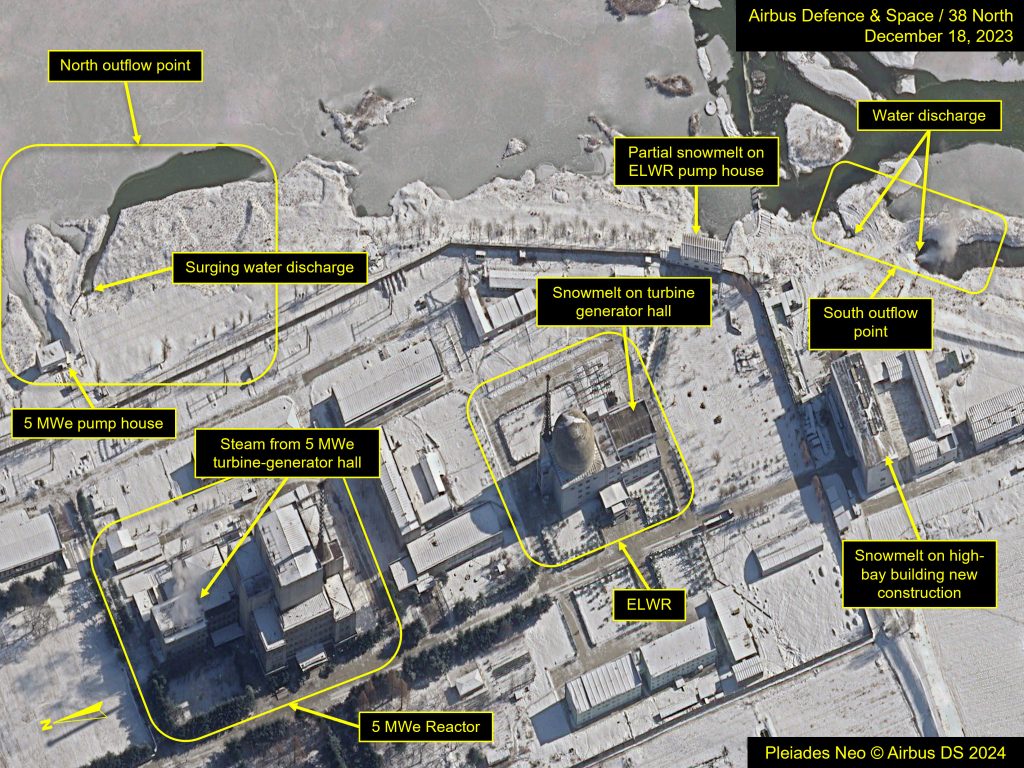
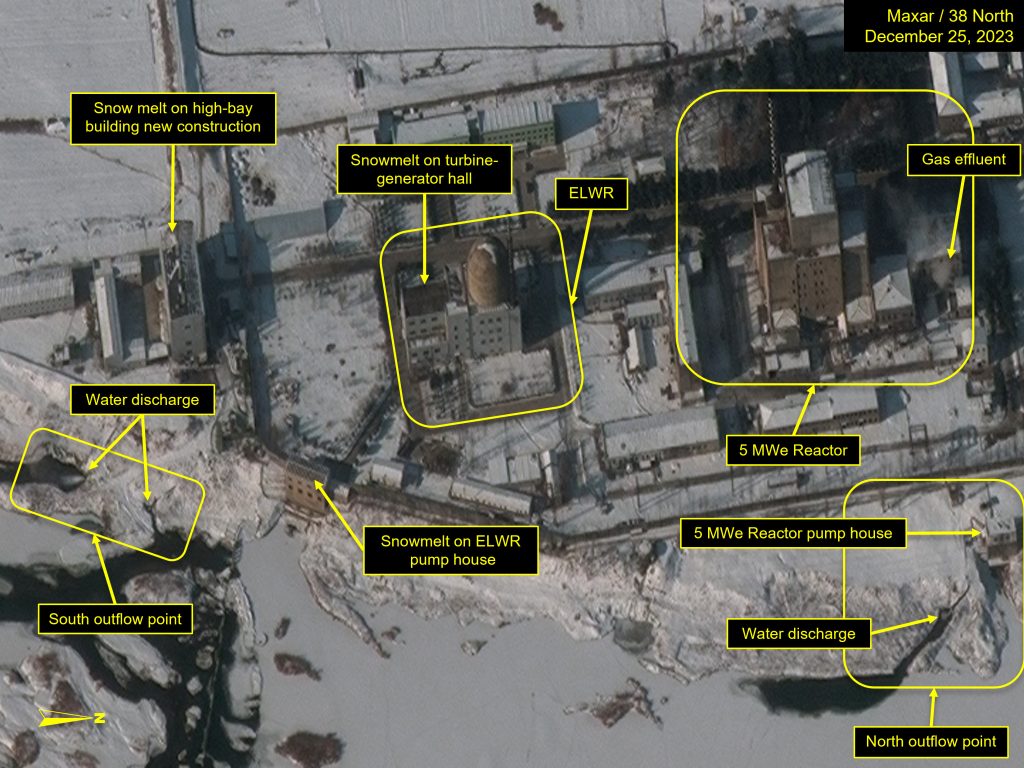
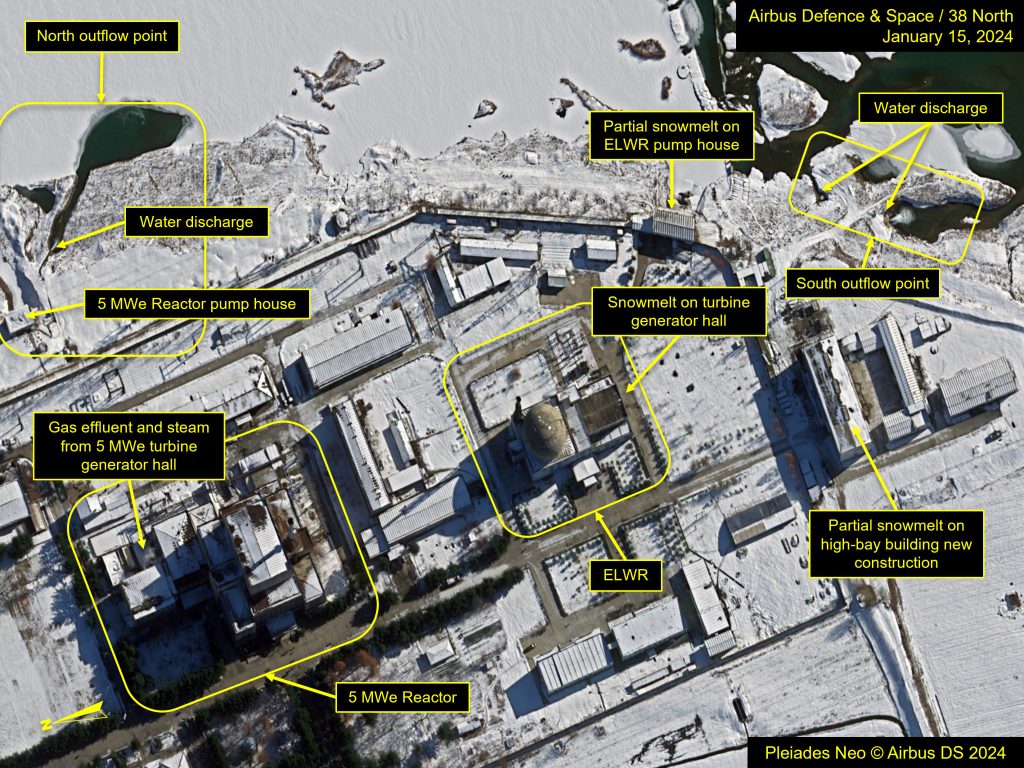
5 MWe Reactor
At Yongbyon, the reactor’s cooling system utilizes water pumped from the adjacent Kuryong River to cool the heat exchangers, and warmed water is subsequently released back into the river downstream.[2] The outflow of liquid effluent from a pipeline at the reactor complex, along with the steam effluent from the turbine generator, are the two common indicators used by analysts to assess the operational status of North Korea’s 5 MWe Reactor. Based on such signals, we confirm that the 5 MWe Reactor is operating as of January 2024, despite a brief stop in October 2023. One year of operation of this reactor is expected to generate up to 6 kilograms (kg) of plutonium, approximately enough to make a single atomic bomb.
ELWR
In April 2021, large construction efforts near the ELWR complex were observed. Commercial satellite imagery revealed a substantial three-story building compound under construction, about 100 meters south of the ELWR’s turbine-generator hall. The purpose of this building remains uncertain, but the proximity to the ELWR prompted speculation that it might be associated with supporting the ELWR operation.
The construction of this compound appears to have been completed by August 2022. After its completion, periodic releases of small volumes of water were noted east of this complex into the river at the terminus of the suspected ELWR cooling lines.
Today, two water discharge outlets are visible south of the ELWR pump house. The first, with a smaller discharge flow, is located closest to the pump house, and the second is located ~35 meters south and expels a larger volume of water. Based on our imagery analysis, the large south discharge point originates from the south side of the ELWR’s turbine-generator hall, as evidenced in the image dated March 28, 2013 (Figure 10). The pipeline trenching for the smaller north discharge point was first noted on imagery taken in 2012. It is possible that this small north discharge point is associated with the ELWR’s long-term testing of auxiliary and emergency systems or connected to the new construction.
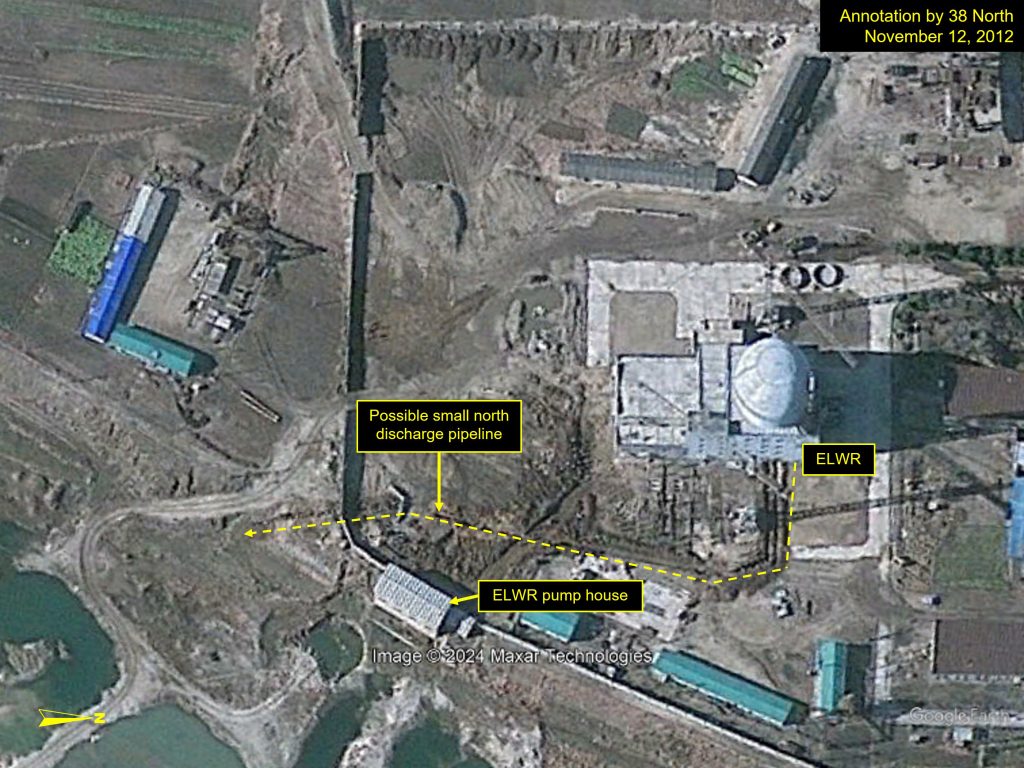
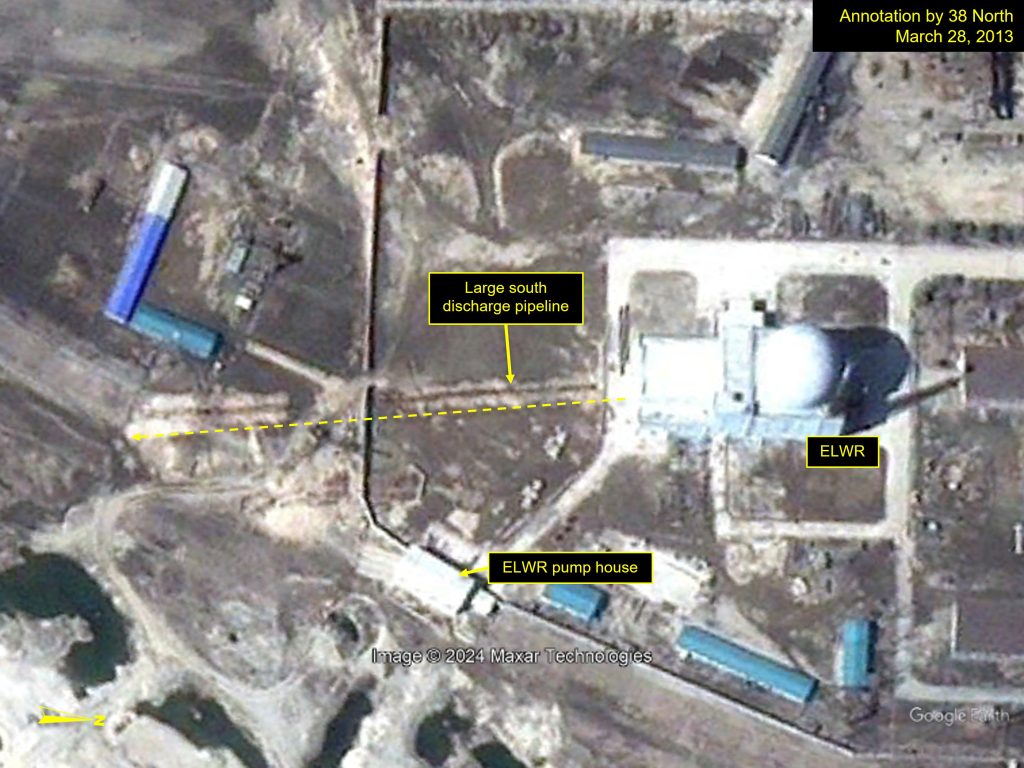
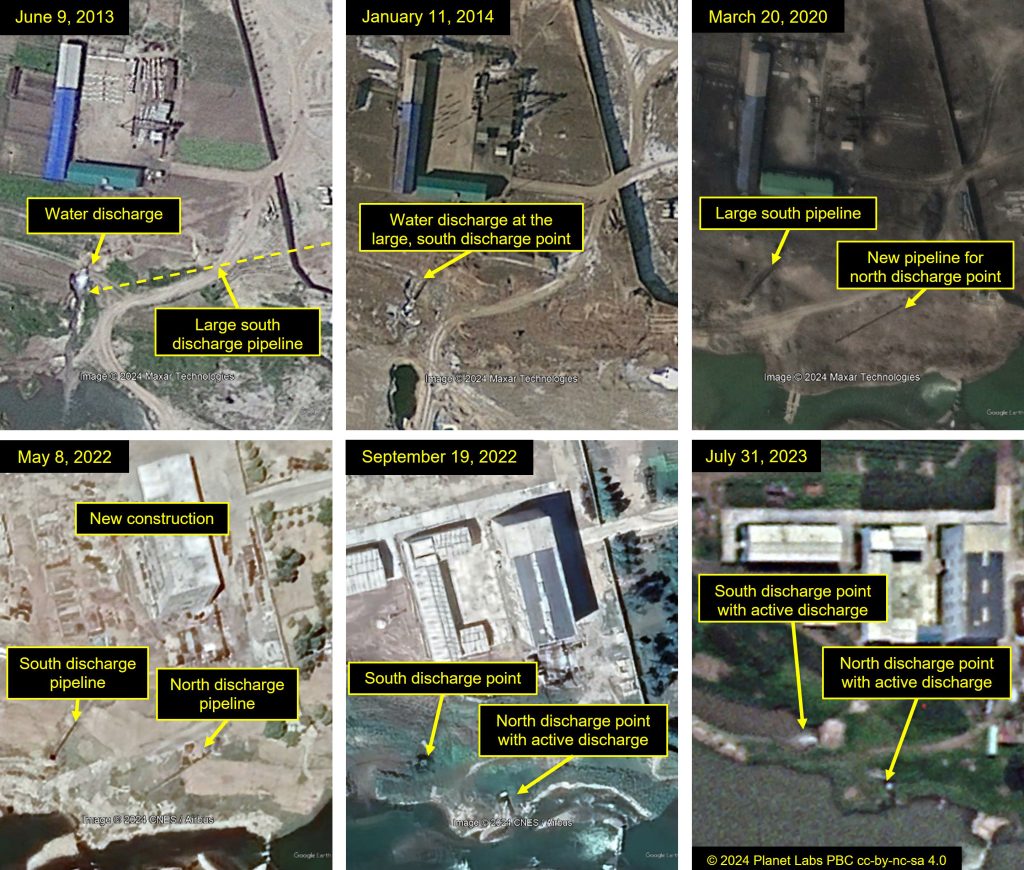
While periodic water discharge was observed at the large south discharge point, it was not until the beginning of October 2023 that consistent and larger outflows were noted at both outflow termini—prompting speculation for potential criticality (or steady operation) at the ELWR. Additionally, roof snowmelt has been observed at the ELWR’s turbine-generator hall, pump house, and high-bay building—suggesting some level of operation. While roof snowmelt has been previously observed at the ELWR’s turbine-generator hall, the melt has notably occurred more quickly this year.
Unlike the 5 MWe Reactor, assessing the operational status of the ELWR with water outflow has proven challenging, largely due to the absence of observable indications of effluent release from the turbine-generator hall and unverified information regarding the direct linkage of the water discharged from the pipelines to and from the ELWR. Notably, there has not been any direct on-site inspection of the ELWR to confirm the function of the cooling arrangements, in contrast to the 5 MWe Reactor, which was visited by US delegates and IAEA officers until 2010.[3] Despite the challenge, it is crucial to keep a close eye on the ongoing activities and grasp the possible implications.
Thermal Imagery
Recent high-resolution thermal images from SatVu shed light on North Korea’s nuclear activities by enabling direct detection of heat sources.
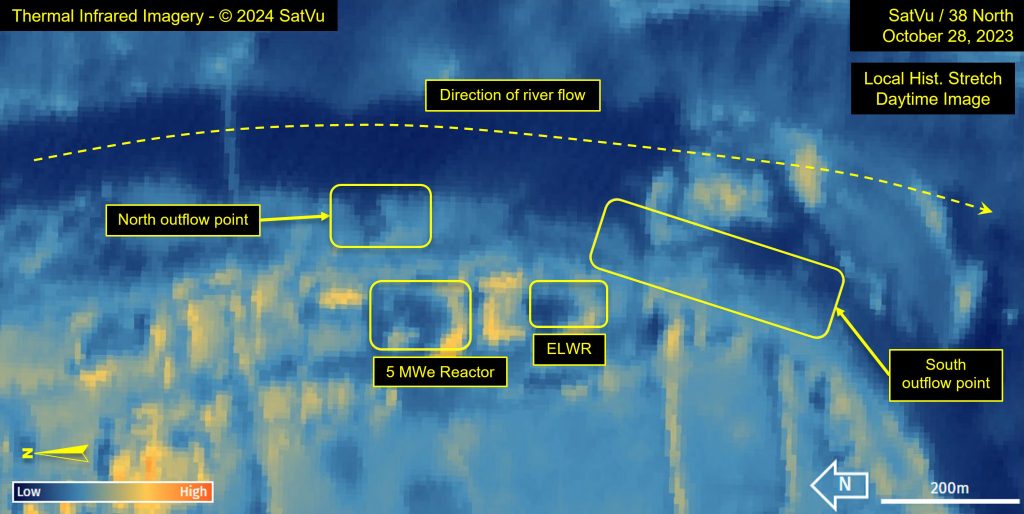
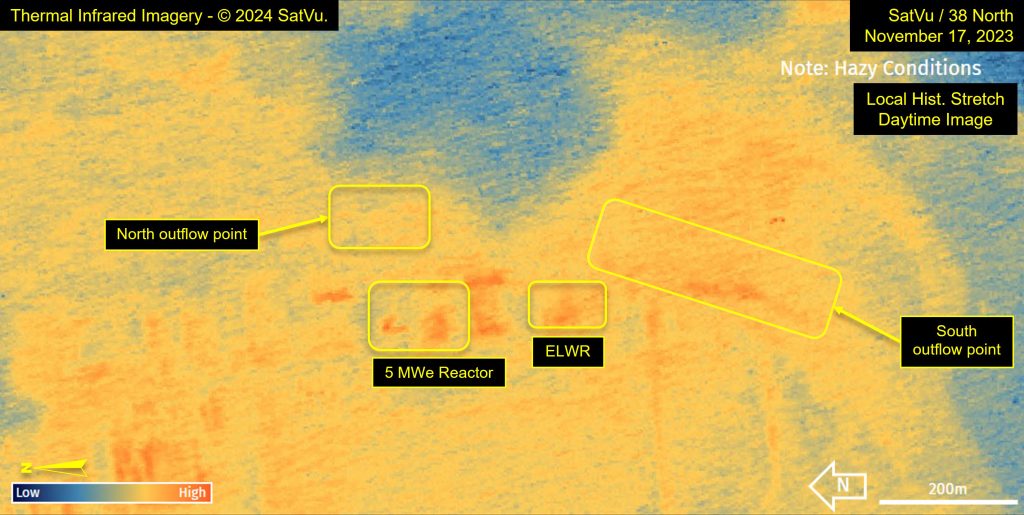
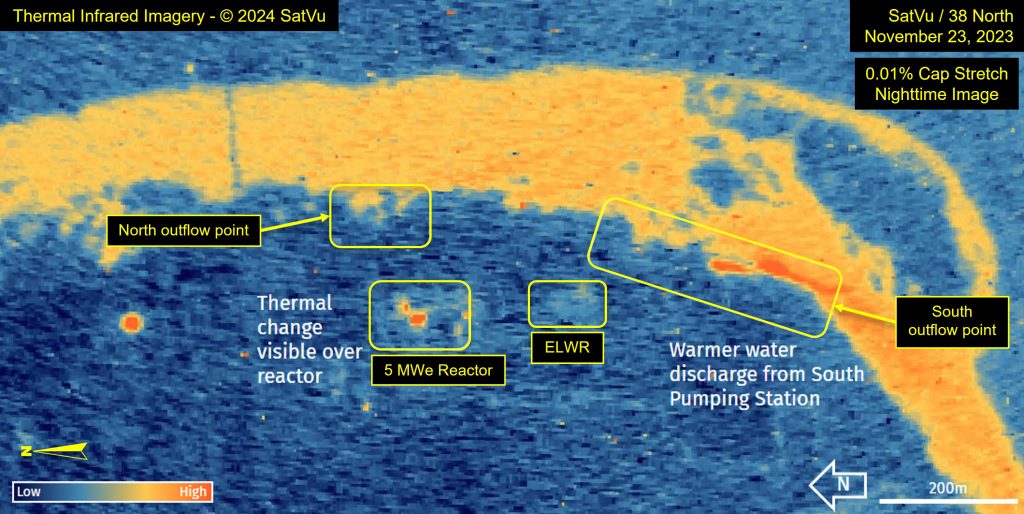
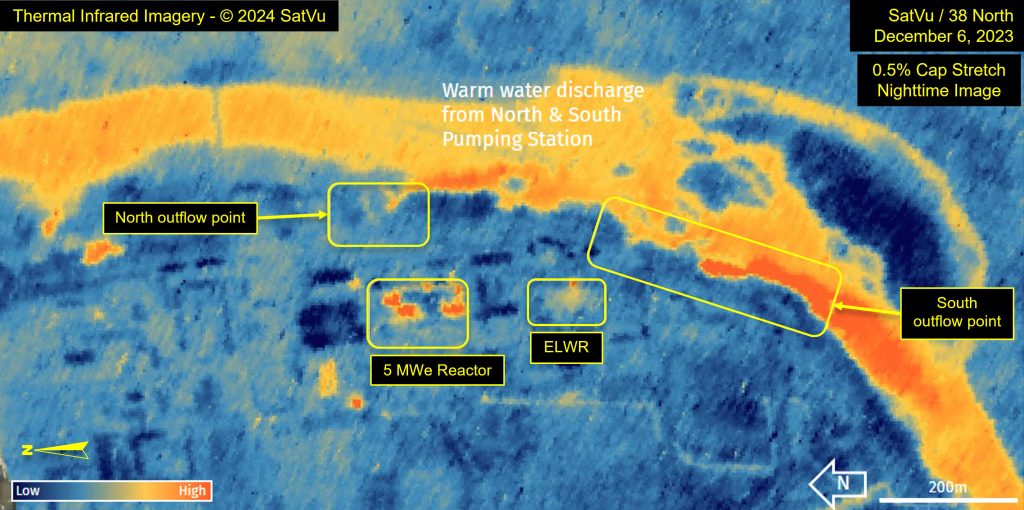
5 MWe Reactor
Analysis of high-resolution thermal satellite imagery and complementary optical imagery reveals a “trifecta” of signatures, validating the reactor criticality at the 5 MWe Reactor: a strong heat signature of the reactor and its turbine-generator hall, a steam effluent emanating from the turbine-generator hall, and thermal plume of water discharge from the north outflow point, the latter notably captured by a nighttime thermal image dated December 6, 2023 (Figure 15).
ELWR
The ELWR shows a significant surge of warm water turbulence emanating southwest of its turbine-generator hall, consistent with the water effluent observed on the corresponding optical imagery. The heat signature from this thermal plume is greater than that of water discharged from the 5 MWe Reactor, both in terms of the relative temperature and volume. The nighttime images prominently highlight the significant heat anomaly in the effluent emerging from the south outflow point. But notably, the thermal signatures from the ELWR dome, which houses the reactor core and its turbine-generator hall, are significantly muted when compared with the thermal signature from the 5 MWe Reactor. The only discernible heat signature comes from what appears to be the ELWR power switchyard.
South Outflow Point
The large volume and stronger heat signature observed in the water discharge near the ELWR can be attributed to its overall thermal output and its location downstream of the 5 MWe Reactor. The ELWR is designed to generate thermal output about four times greater than that of the 5 MWe Reactor. The higher thermal output means more water is needed for cooling due to the greater heat generated by the reactor. Yet, the location of the ELWR downstream of the 5 MWe Reactor means that the residual hot plume from the 5 MWe Reactor is mixed with the cold river water, increasing the overall temperature of water required to cool the ELWR, located downstream of the 5 MWe Reactor outflow.
As seen in the infrared image from December 6, 2023, the thermal plume of water from the 5 MWe Reactor extends along the bank downstream, reaching what may be the main intake point of the ELWR. The reduced thermal efficiency necessitates a higher volume of water inflow to adequately cool the reactor, consequently resulting in an increased outflow volume at the ELWR.
Heat Signature
With the ELWR designed to produce approximately four times the energy output of the 5 MWe Reactor, we would expect a moderately higher heat signature from the ELWR when compared with the 5 MWe Reactor under optimal operating conditions. Yet, the thermal images reveal a significantly reduced heat signature from the ELWR. Certainly, the different construction materials and characteristics of the two reactors pose a challenge for a direct comparison of heat signatures. Notably, the 5 MWe Reactor lacks a containment shell, resulting in a more intense thermal signature, while the ELWR features a doublewall construction of the dome house involving a 20-30 centimeter thick steel pressure vessel encased within a containment structure that is ~0.9 meters thick (Figure 17). The containment is intended to retain radioactivity released during accidents.
The infrastructure of the ELWR can influence the observed heat signature, as the vessel itself retains heat and contributes to the overall thermal profile observed in thermal images of the reactor. However, it is doubtful that the containment structure eliminates the heat signature entirely or dampens the heat signature substantially.
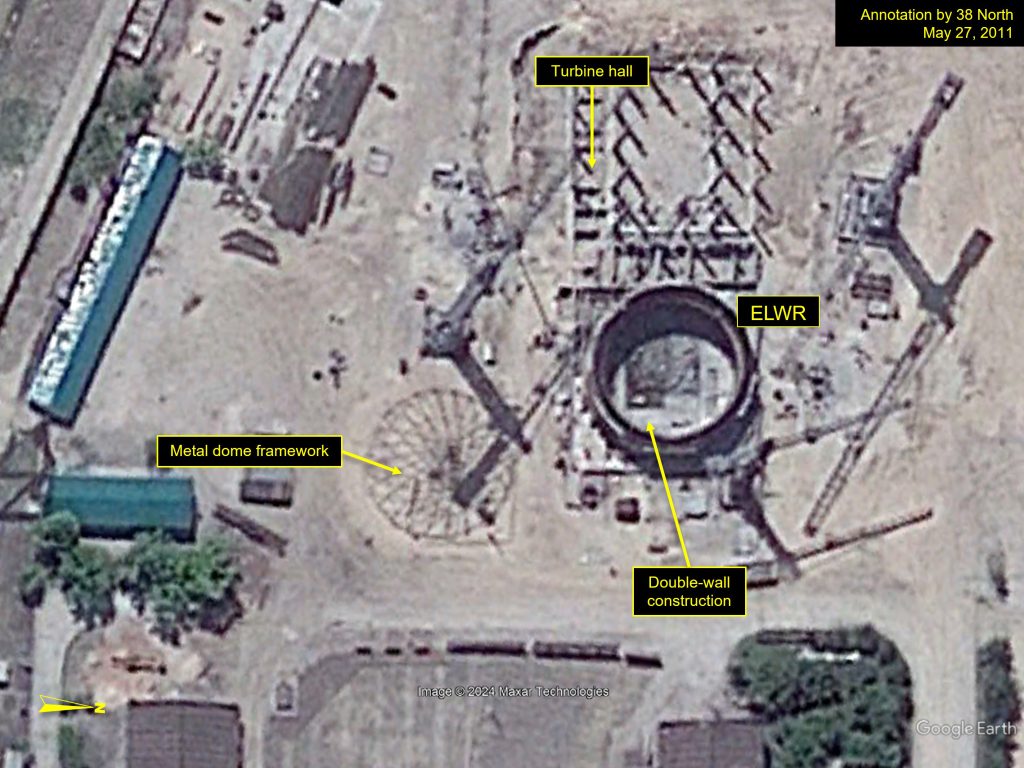
The muted heat signature from the ELWR could indicate two possibilities: a pre-operational testing phase, or a low-power operation mode in a “ramp-up” phase.
Pre-operational testing phase includes extended steps designed for performance evaluation prior to operation. For example, North Korea could be conducting tests for coolant circulation systems and heat exchangers responsible for removing excess heat. The testing scenario produces a heat plume in the discharged water without significantly elevating the reactor’s temperature to the level expected during regular operation. The hot water discharge could result from water heated by a temporarily installed oil heater that circulates through the turbine generator system for performance evaluation preceding its coupling with the reactor. Correspondingly, the hotspot at the ELWR switchyard observed on the December 6 thermal image could be indicative of power from the grid being used to run the pre-operational tests.
However, the continuous surging of substantial outflows at the ELWR discharge points since October could also suggest that the ELWR has begun operating, albeit at a reduced power level than initially designed. All reactors undergo a normal “ramp-up” phase, in which they operate at a lower capacity before reaching maximum capacity. Typically, the gradual ramp-up of a reactor takes six months to a year. North Korea could be at the earlier stage of the ramp-up phase, which might explain the muted heat signature at the reactor dome.
Continuous monitoring is warranted to verify that the heat signature from the ELWR gradually increases over time.
Implications of ELWR Operations
ELWR operations could impact North Korea’s nuclear weapons program and denuclearization efforts. Its potential dual use for energy generation or weapons-grade material production poses complex challenges for future denuclearization discussions, if they are ever revived, and raises major concerns about managing spent fuel and reactor decommissioning.
Should North Korea effectively repurpose the ELWR for plutonium production, it has the potential to amplify the rate of plutonium production by threefold or more compared with the current production capacity of the 5 MWe Reactor alone. For instance, North Korea could enhance fissile material production using the ELWR by incorporating blankets, from which plutonium can be created and then separated by reprocessing. “Blankets” are regions of fertile material surrounding the reactor core. These blankets can be composed of tubes with natural uranium that capture fast neutrons and transmute uranium-238 into fissile isotopes of plutonium, e.g., plutonium-239, a critical ingredient for nuclear weapons. However, blankets are not optimal for light water reactors as they require adjustments to the neutron spectrum and introduce additional challenges in terms of safety and control.
A more likely way North Korea can strategically aim to produce plutonium is by reducing the burnup (total energy generated per unit mass of fuel), i.e., limiting the extent to which the fuel is burned or irradiated during the reactor’s operational cycle. By discharging fuel assemblies before they have undergone a full burnup (standard burnup for pressurized-water reactor designed for electricity generation is ~33,000 megawatt-days per metric ton of uranium (MWd/MtU)), it is possible to achieve higher concentrations of fissile material isotopes in the spent fuel, making the products better for weapons. According to Albright, the yearly projection for plutonium production was ~20 kg, assuming a 70-80 percent capacity factor applied for a year, and a plutonium conversion of 0.85 at full operation, taking into consideration a 10 percent reduction in plutonium output.[4] Considering the additional time required for the spent fuel to cool down and to be reprocessed, the newly separated plutonium from the ELWR could be accessible from 2025 onwards.
However, if North Korea chooses to augment its fissile material stockpile for weapons production, there are several additional considerations that must be taken into account, including its reprocessing capacity and tritium production.
North Korea’s reprocessing facility, the Radiochemical Laboratory (RCL) was originally configured to process low-burnup MAGNOX-type fuels that are used for the 5 MWe Reactor. To handle the different types of fuel from the ELWR, North Korea has to modify the “head-end”—the initial stages of the reprocessing, involving some degree of disassembly, shearing, and dissolution—as well as the first extraction cycle of the spent fuel. The construction and refurbishment activities at the RCL in the past year could have been intended to facilitate such processes.
Producing more nuclear weapons also means North Korea will have to produce more tritium—an important ingredient to increase the efficiency and yield in making hydrogen bombs. The short half-life of tritium (12.3 years) means that North Korea has to regularly replenish tritium to maintain an effective nuclear stockpile.
In anticipation of the tritium requirement, North Korea built the Radioisotope Production Plant as early as 2015, though it remains unclear if the plant is currently in full operation. North Korea could be producing tritium from Russia-supplied IRT 2000 reactor or by using the 5 MWe Reactor, though the latter at the expense of making plutonium.
It is crucial to recognize that even with North Korea’s potential full engagement of the ELWR’s reactor core, it remains premature to determine whether it will employ this reactor for energy or military purposes. The powerlines associated with the ELWR affirm North Korea’s intent to use the ELWR for electricity generation. Nevertheless, the possibility lingers that the operation of the ELWR is strategically aligned to enhance North Korea’s nuclear weapons capabilities, in line with Kim Jong Un’s directive at the end of 2022 for an “exponential increase of nuclear arsenal“ and stated need to “produce more nuclear materials.”
North Korea has not provided any words or data on the developments at the ELWR to date. And today, North Korea’s pursuit of ELWR remains a significant focus of international scrutiny, with unresolved questions surrounding its purpose and potential implications for nuclear programs. Continuous monitoring is needed to ascertain when and how the reactor is operated.
- [1]
[1] Siegfried S. Hecker and Elliot A. Serbin, “Why an Indigenous LWR?” in Hinge Points: An Inside Look at North Korea’s Nuclear Program (Stanford: Stanford University Press, 2023), 263.
- [2]
In a pressurized water reactor, there are three heat transfer loops. The primary loop that involves the transfer of heat within the reactor core; a heat exchanger that transfers the primary loop heat to the secondary loop, which boils the specially treated water to produce steam and spin the turbine generator; and a tertiary heat exchanger that condenses the spent steam into condensate. The condensate is then pumped back into the secondary loop heat exchanger, where it is boiled into steam again. The river water is utilized to cool the tertiary heat exchanger. It is crucial to note that the working fluids in the primary and secondary loops need to remain pure to prevent corrosion.
- [3]
See, for example, Siegfried S. Hecker, “A Return Trip to North Korea’s Yongbyon Nuclear Complex,” Stanford Center for International Security and Cooperation Freeman Spogli Institute, November 20, 2010, https://fsi9-prod.s3.us-west-1.amazonaws.com/s3fs-public/HeckerYongbyon.pdf; Director General of the IAEA, Applications of Safeguards in the Democratic People’s Republic of Korea, GOV 2022/40-GC(66)/16, September 7, 2022, https://www.iaea.org/sites/default/files/gc/gc66-16.pdf; and “Verification in the DPRK,” International Atomic Energy Agency, November 20, 2020, https://www.iaea.org/newscenter/focus/dprk.
- [4]
See David Albright, “North Korean Plutonium and Weapon-Grade Uranium Inventories,” Institute for Science and International Security, January 8, 2015, https://isis-online.org/uploads/isis-reports/documents/North_Korean_Fissile_Material_Stocks_Jan_30_2015_revised_Oct_5_2015-Final.pdf; David Albright, Sarah Burkhard, Victoria Cheng and Spencer Faragasso, “North Korea’s ELWR: Finally Operational After a Long Delay,” Institute for Science and International Security, January 23, 2024, https://isis-online.org/uploads/isis-reports/documents/North_Koreas_ELWR_January_2024_Final.pdf.
